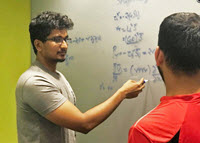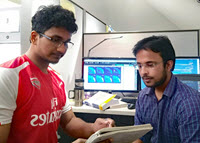
Oil, gases, and bubbles jet out together during a deep-ocean petroleum blowout, and the oil quickly breaks up into different-sized droplets. Predicting the sizes of these droplets is critical to determine how long it will take the oil to reach the ocean’s surface and the resulting oil slick’s size. Aditya Aiyer is developing a new approach for state-of-the-art models that simulate oil’s behavior as it moves through turbulent flows and track the subsequent different-sized oil droplets’ breakup and coalescence. The improved simulations of the fate and evolution of oil droplets in deepwater plumes can inform decisions about dispersant application.
Aditya is a Ph.D. student with the Johns Hopkins University’s Department of Mechanical Engineering. He is a GoMRI Scholar working on the project Transport and Fate of Oil in the Upper Ocean: Studying and Modeling Multi-Scale Physical Dispersion Mechanisms and Remediation Strategies Using Large Eddy Simulation.
His Path

Aditya developed an interest in science from his father, an enthusiastic physics professor who loved to explain the world around him. Seeing his father’s passion inspired Aditya to pursue a bachelor’s degree in mechanical engineering at the Birla Institute of Technology and Science, one of India’s leading private institutions. He became attracted to the practical applications of fluid dynamics while working towards a master’s degree in physics. Looking at everyday things, such as water flowing from a faucet or cream being added to coffee, from a physics perspective fascinated him. Aditya later took a research associate position at the Tata Institute of Fundamental Research to study atmospheric flows and cloud formation, an unsolved problem when conducting climate modeling. Wanting to delve further into unresolved questions in his field, Aditya began exploring Ph.D. programs and joined Dr. Charles Meneveau’s team researching oil spills.
“After my time at Birla Institute of Technology and Science, I wanted to further explore how I could use my knowledge of physics and fluid dynamics to help make an impact on our lives,” said Aditya. “I’m very excited to work with oil spills, as the results of our research could have a tremendous impact on the environment.”
His Work

Aditya uses Large Eddy Simulations to investigate the dynamics between oil droplets and turbulent flows. These model outputs allow him to accurately depict turbulent flows and their effects on oil breakup, either as an oil jet (similar to a deep-water blowout) or in a less-turbulent environment. “Traditional models use Reynolds Averaged Navier Stokes Equations, which need a separate model for turbulence. Using the Large Eddy Simulations, we can capture the effects of turbulence directly, making our simulation closer to what is actually happening in a blowout,” said Aditya. The combination of simulations and equations better depicts the concentration of oil droplets and how they change due to breakup, coalescence, and advection.
Aditya and his colleagues use existing data from similar experiments to validate their model. He explained that their model can predict oil concentrations and size distributions at a given location and time during a blowout. The droplet size distribution tells him how many droplets of different sizes have been generated due to breakup and coalescence, allowing him to infer the droplet’s fate. “Larger droplets would move quickly to the surface, while smaller ones would be more influenced by the local turbulence and might remain underwater. We can also evaluate how much of the oil volume would reach the surface and the time it would take them to do so,” explained Aditya. “Such results can be used to build simpler, better models that can give responders an idea of where they should apply dispersants or other chemicals to deal with the spill.” He hopes to expand his team’s simulation models to include other factors that may affect oil fate, such as dispersant application, to better inform responders’ decision making.
His Learning
Working with Meneveau taught Aditya the importance of approaching problems from the foundation up. He learned to approach problems in sections, starting with the issue’s first principles and then continuously incorporating the issue’s more complex aspects until he reaches his goal. Aditya also reflected on his experiences in the GoMRI science community and engaging with other scientists at the Gulf of Mexico Oil Spill and Ecosystem Science Conference, “There are hundreds of people [in the GoMRI community] working on a myriad of topics from the chemistry and physics of the oil all the way to the ecological effects and effects on local aquatic life. It was humbling to see that my research is also playing a small role in saving our environment.”
His Future
Aditya plans to work towards a university faculty position, where he can apply his love for teaching and working in a research environment, or towards conducting research in a federal or industry position. He said that students interested in a scientific career should remember the importance of having strong fundamentals, “Most ideas a scientist comes up with aren’t due to them knowing some esoteric part of the field, but by having very strong basics. The ability to think clearly and make good inferences based on the fundamental principles of your field is a skill I think every student pursuing science must cultivate and make a part of their repertoire.”
Praise for Aditya
Dr. Meneveau praised Aditya’s contributions to his research team, particularly his development of their new approach to the Large Eddy Simulation toolset. “Thanks to Aditya’s work, we are now able to model the evolution of the entire size distribution,” he said. “Aditya has contributed excellent ideas and done careful tests of the approach he has developed. We look forward to applying the model to realistic flow conditions.”
The GoMRI community embraces bright and dedicated students like Aditya Aiyer and their important contributions. The GoMRI Scholars Program recognizes graduate students whose work focuses on GoMRI-funded projects and builds community for the next generation of ocean science professionals.
By Stephanie Ellis and Nilde Maggie Dannreuther. Contact sellis@ngi.msstate.edu for questions or comments.
************
The Gulf of Mexico Research Initiative (GoMRI) is a 10-year independent research program established to study the effect, and the potential associated impact, of hydrocarbon releases on the environment and public health, as well as to develop improved spill mitigation, oil detection, characterization and remediation technologies. An independent and academic 20-member Research Board makes the funding and research direction decisions to ensure the intellectual quality, effectiveness and academic independence of the GoMRI research. All research data, findings and publications will be made publicly available. The program was established through a $500 million financial commitment from BP. For more information, visit https://gulfresearchinitiative.org/.
© Copyright 2010-2018 Gulf of Mexico Research Initiative (GoMRI) – All Rights Reserved. Redistribution is encouraged with acknowledgement to the Gulf of Mexico Research Initiative (GoMRI). Please credit images and/or videos as done in each article. Questions? Contact web-content editor Nilde “Maggie” Dannreuther, Northern Gulf Institute, Mississippi State University (maggied@ngi.msstate.edu).
